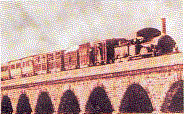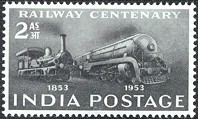
![]()
The development of railways in India started on all sides after successful initial projects in the west and the east.
West :
On 16th April, 1853 the first railway on
Indian sub-continent ran over a stretch of 21 miles from Bombay to Thane . The
idea of a railway to connect Bombay with Thane, Kalyan and with the Thal and
Bhore Ghats incline first occurred to Mr. George Clark, the Chief Engineer of the Bombay Government,
during a visit to Bhandup in 1843.The first Indian train steamed off from
Bombay(Bori Bunder) to Thane on 16th. April 1853, at 3:30 P.M. "amidst the
loud applause of a vast multitude and to the salute of 21 guns." The train
consisting of 14 carriages was hauled by three locomotives named Sultan, Sindh and Sahib
with 400 VVIPs The formal
inauguration ceremony was performed on 16th April 1853, when 14 railway
carriages carrying about 400 guests left Bori Bunder at 3.35 PM.
first occurred to Mr. George Clark, the Chief Engineer of the Bombay Government,
during a visit to Bhandup in 1843.The first Indian train steamed off from
Bombay(Bori Bunder) to Thane on 16th. April 1853, at 3:30 P.M. "amidst the
loud applause of a vast multitude and to the salute of 21 guns." The train
consisting of 14 carriages was hauled by three locomotives named Sultan, Sindh and Sahib
with 400 VVIPs The formal
inauguration ceremony was performed on 16th April 1853, when 14 railway
carriages carrying about 400 guests left Bori Bunder at 3.35 PM.
In the East :
The Survey from Calcutta to Delhi was carried out by Mr. Stephenson during 1845-46. The construction of railway line from Howrah to Raniganj was sanctioned only after 3 years. But by the end of 1853 61 kms. of line was ready upto Pandooah. Two historical incidents denied EIR , the first position in history of railways in India.. The Locomotive Engine and the carriages for both the trains of Bombay and Howrah were despatched from England almost at the same time, but the ship carrying the loco for E.I.R. (HMS Goodwin) was misdirected to Australia and the other carrying the carriages for Howrah sank at Sandheads. Otherwise Howrah would have had the legacy of running the first train in India. The Locomotive Engine and the carriages for both the trains of Bombay and Howrah were despatched from England almost at the same time, but the ship carrying the loco for E.I.R. (HMS Goodwin) was misdirected to Australia and carriages for Howrah sank at Sandheads. The other problem faced was that the line was aligned through Chandernagore (Chandannagar) which was a French territory at that time. The settlement of this dispute with french rulers of Chandernagore also took considerable time. The Locomotive reached Calcutta via Australia and a trial run was made on 28th. June 1854. The coaches for the first train was however manufactured by two Calcutta based companies Steward & Company and Seton & Company. Otherwise Howrah would have had the legacy of running the first train in India.
The first passenger train steamed out of Howrah station destined for Hooghly, (click) a distance of 24 miles, on 15th August, 1854. Thus the first section of the East Indian Railway was opened to public traffic, inaugurating the beginning of railway transport on the Eastern side of the sub-continent.
From 15th August 1854, the company ran regular services, morning and evening, between Howrah and Hugli with stops at Bally, Srerampore and Chandannagar. The fare ranged from Rs.3 by first class to 7 annas by third class. The main booking office was on the Calcutta bank, at the Armenian Ghat, and the fare covered the ferry to the station. At the Howrah end, the station consisted of a tin shed and a single line flanked by narrow platforms, somewhat to the south of the present station building constructed between 1901 and 1906.
In the South the first line was opened on Ist July, 1856 by the Madras Railway Company. It ran between Veyasarpandy and Walajah Road (Arcot), a distance of 63 miles. the first line was opened on Ist July, 1856 by the Madras Railway Company. It ran between Veyasarpandy and Walajah Road (Arcot), a distance of 63 miles.
In the North a length of 119 miles of line was laid from Allahabad to Kanpur on 3rd March 1859. The first section from Hathras Road to Mathura Cantonment was opened to traffic on 19th October, 1875.
These were the small beginnings
which is due course developed into a network of railway lines all over the
country. By 1880 the Indian Railway system had a route mileage of about 9000
miles.
( Source : Old Eastern Railway Magazines of 1953)
Here are some of the many commemorative postage issued in India for different occasions of Indian Railways.


